
Vimercate is a comune (municipality) in the province of Monza and Brianza, in the Italian region of Lombardy. It is 25 kilometres (16 mi) from Milan and 10 kilometres (6 mi) from Monza.
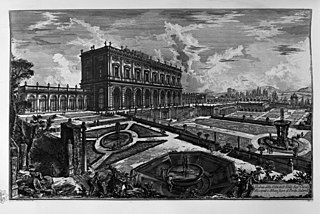
The Villa Albani is a villa in Rome, built on the Via Salaria for Cardinal Alessandro Albani. It was built between 1747 and 1767 by the architect Carlo Marchionni in a project heavily influenced by others – such as Giovanni Battista Nolli, Giovanni Battista Piranesi and Johann Joachim Winckelmann – to house Albani's collection of antiquities, curated by Winckelmann. The villa has been conserved intact into the 21st century by the Torlonia Family, who bought it in 1866. In 1870, the treaty following the Capture of Rome from the Papal States was signed here.

The Basilica dei Santi Bonifacio e(d) Alessio is a basilica, rectory church served by the Somaschans, and titular church for a cardinal-priest on the Aventine Hill in the third prefecture of central Rome, Italy.

San Marco is a church in Milan, northern Italy.

Villa Carlotta is a villa and botanical garden in Tremezzo on Lake Como in Northern Italy. Today the villa is a museum, whose collection includes works by sculptors such as Antonio Canova, Bertel Thorvaldsen, and Giovanni Migliara; painters such as Francesco Hayez; and furniture pieces of previous owners. The villa, whose architect is unknown, was completed in 1745.

The Royal Villa is a historical building in Monza, northern Italy. It lies on the banks of the Lambro river, surrounded by the large Monza Park, one of the largest enclosed parks in Europe.
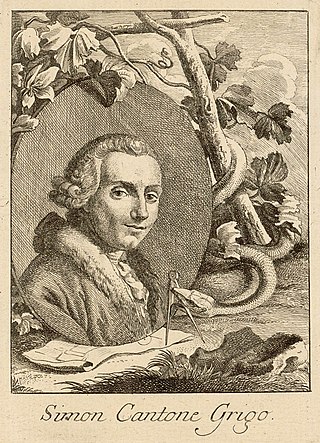
Simone Cantoni was a Swiss architect of the Neoclassical period, active mainly in Northern Italy.
The Villa Arconati, also known as the Castellazzo Degli Arconati, is a rural palace and gardens, located in the district of Castellazo of the town of Bollate, northwest of Milan, Italy. Built-in a grand Baroque style over the 17th and 18th centuries, it now functions as a museum and host for events and meetings.
Villa Alari, also known as the Villa Visconti di Saliceto, is a Rococo style rural palace in Cernusco sul Naviglio, in the Province of Milan, in the Region of Lombardy, Italy.
The Villa Scheilbler Gallarati Scotti is a 16th-century hunting lodge and rural palace located in the town of Rho in the province of Milan, Region of Lombardy, Italy. This villa differs from the Villa Gallarati Scotti at Vimercate.
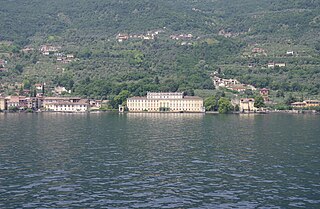
Villa Bettoni is a large lake-side Neoclassical-style rural palace located in the frazione of Bogliaco, on the shores of Lake Garda, within the town limits of Gargnano, Province of Brescia, region of Lombardy, Italy. The villa includes lakefront and gardens.

The Villa La Rotonda is a 19th-century villa located on Via Privata D'Adda #2 just outside the town of Inverigo, Province of Como, Lombardy, Italy.
The Villa Litta Modignani is a 17th-century rural palace and park located on Via Taccioli in the north suburbs of Milan, in the Province of Milan, Lombardy, Italy.

The Palazzo Ghirlanda-Silva is a patrician building in the old town of Brugherio, Italy. Built in the first half of the nineteenth century, it now houses the public library. It has an area of 1,992 m2 (21,440 sq ft), of which 1,407 m2 (15,140 sq ft) are used for library services, with the remaining space providing an exhibition room, an auditorium and offices.

Villa Scotti-Cornaglia-Noseda-Bertani, commonly known as Villa Fiorita, is a building in Lombardy, Italy, where the Brugherio Comune's headquarters are housed.

Cassina Baraggia is a hamlet of Brugherio's municipality, which until 1866 was a separate municipality.
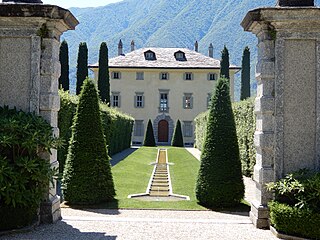
The Villa del Balbiano is a villa in Ossuccio, in Lombardy, Italy.
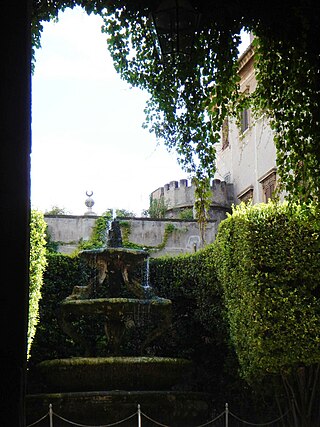
Palazzo Taverna is a palace in Rome, located on the Via di Monte Giordano and first built under orders of Cardinal Giordano Orsini, who wished to turn his ancient castle on the Monte Giordano into a residence. It was the residence of Adriana in when she was overseeing the education of the children of the man who would be elected Pope Alexander VI: Lucrezia Borgia, Juan Borgia and Cesare Borgia. It was later rented by notable figures such as cardinals Ippolito II d'Este, who used it to host Torquato Tasso, and Maurizio di Savoia.
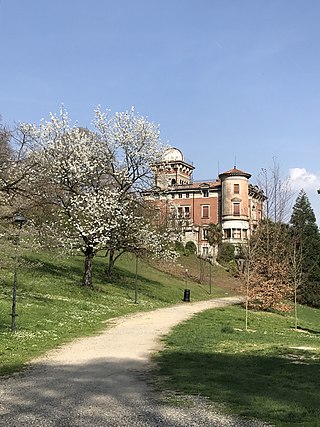
Villa Toeplitz is a historic villa located in Varese, Lombardy, Italy. Construction was complete by 1901 and subsequently named after the banker Jósef Leopold Toeplitz, who bought the villa in 1914. It previously belonged to the Hannesens, a German family that used it as a country holiday house.

The Palazzo del Giardino or Palazzo Ducale del Giardino is a historic palace in the Parco Ducale in Parma. It is not to be confused with the official Parma residence of Marie Louise, Duchess of Parma between Palazzo della Pilotta and Palazzo della Provincia in what is now known as piazzale della Pace - she also lived at the Ducal Palace of Colorno and in the Casino dei Boschi in Sala Baganza. The main Ducal Palace in Parma, the Palazzo della Pilotta and the Reinach Theater were all destroyed in an early morning air raid on 13 May 1944, carried out by the 465th Heavy Bombardment Group of the US Airforce, 781st Squadron, which dropped 9 GP bombs on the city centre.
















